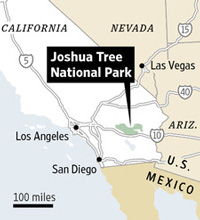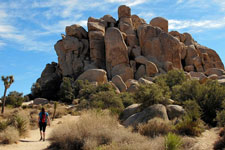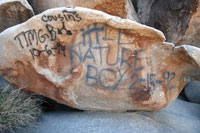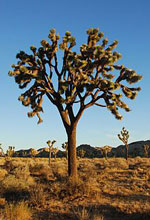redo Jump to...
print Print...
(by Tamara Audi, The Wall Street Journal) – For years, millions of visitors drawn to the peculiar beauty of Joshua Tree National Park have …picked up their trash and heeded authorities’ pleas to leave the park’s granite monoliths and blooming desert floor unmolested.
But in recent months the park has been hit with an unusual [amount] of graffiti. Last week, the escalating problem prompted park rangers to close a large area of the attraction because of widespread graffiti found in a popular canyon. That came on the heels of the closure of another part of the park after it also had been defaced. More than 300 acres are shut to visitors while officials investigate.
“People are appalled and people are wondering how it could happen here, in a national park,” said Pat Pilcher, a ranger at Joshua Tree.
 Most of the park, which sits 140 miles east of Los Angeles at the crossroads of the Mojave and Colorado deserts, is still open. But the closures come at the height of the park’s busy season, and affect one of its most popular areas, Rattlesnake Canyon, which is rugged and remote, with large rock formations and water pools fed from a natural spring. The park attracts about 1.3 million visitors a year. …
Most of the park, which sits 140 miles east of Los Angeles at the crossroads of the Mojave and Colorado deserts, is still open. But the closures come at the height of the park’s busy season, and affect one of its most popular areas, Rattlesnake Canyon, which is rugged and remote, with large rock formations and water pools fed from a natural spring. The park attracts about 1.3 million visitors a year. …
Earlier this year, graffiti carvings discovered at another of the park’s historic locations, the Barker Dam, prompted officials to close it to visitors. The trail around the 100-year-old dam is still open, but an area around the dam itself is closed indefinitely, park officials said. Rattlesnake Canyon is scheduled to remain closed for the rest of the month.
The sites are closed while investigators try to track the vandals and assess and repair the damage, park officials said. In pictures released by the National Park Service, the words “oatmeal cookie” and “nature boy” appear to be painted or spray-painted on boulders in Rattlesnake Canyon.
Investigators with the National Park Service, which administers the park, believe that posts on social media played a role by sparking “numerous individuals’ interest in adding to the vandalism,” a National Park Service statement said.
Park officials declined to comment further on the investigation, or reveal which social-media outlets were used. Defacing National Park property carries a maximum sentence of 6 months in prison and a $5,000 fine, they said.
Some of the graffiti may have damaged ancient, Native American petroglyphs, Mr. Pilcher, the park ranger, said. Humans are believed to have settled in the area 5,000 years ago. The damaged rock art might be remnants of early settlements of the Serrano or Chemehuevi Indian tribes, Mr. Pilcher said.
Park officials said they are still determining how to remove the graffiti without doing more damage. It is also unclear how much those efforts might cost, they said.
Vandalism in the country’s 401 national parks is rare, National Park Service officials said, but it still occurs. In 2003, the service saw 7.3 incidents of vandalism per park – which includes graffiti or any other kind of damage – according to federal records. That dropped to 4.8 incidents in 2012.
Some places have seen problems persist. Officials at the Glen Canyon National Recreation Area in Arizona started a Graffiti Removal and Intervention Team, and this year are recruiting volunteers to scrub off graffiti with water and wire brushes, according to the Glen Canyon website.
In the 2012 fiscal year, 287 million people visited national parks, according to federal records.
Jeffrey Olson, a spokesman for the National Park Service, said that normally, if a visitor drops so much as a candy wrapper, he will pick it up immediately or be prodded by others to do so.
“People are protective of their parks,” he said. “It makes it all the more shocking that somebody would defile our heritage.”
Copyright 2013 Dow Jones & Company, Inc. All Rights Reserved. Reprinted here for educational purposes only. Visit the website at wsj.com.
Questions
Note to students: Read the “Background” below before answering the questions.
1. a) How large is Joshua Tree National Park?
b) Where is it located?
c) When was it designated a national park?
d) How many people visit the park each year?
2. How have park officials reacted to the recently escalating graffiti problem in the park (what did they say/what did they do)?
3. a) How much of the park has been closed?
b) For how long will it be closed?
4. What is the penalty for defacing National Park property?
5. Pat Pilcher, a park ranger at Joshua Tree said: “People are appalled and people are wondering how it [graffiti] could happen here, in a national park.” What do you think: are national parks immune to vandalism? (If so, due to what? … the publics’ respect for nature, the amount of effort it would take a graffiti artist/vandal to get to the park, etc.?) Explain your answer.
6. What solutions would you suggest to park officials for the following:
a) how to clean the graffiti off the rocks
b) how to prevent future vandalism
c) how to catch those who have defaced the park already (the sites in the park remain closed while investigators try to track the vandals – what methods do you think they are using to do so?)
Background
The U.S. National Park Service (NPS):
- The National Park Service (NPS) is the U.S. federal agency that manages all national parks, many national monuments, and other conservation and historical properties with various title designations.
- It was created in 1916 by Congress through the National Park Service Organic Act.
- It is an agency of the U.S. Department of the Interior, a federal executive department whose head, the Secretary of the Interior, is a Cabinet officer nominated by the President and confirmed by the Senate.
- Most of the direct management of the NPS is delegated by the Secretary to the National Park Service Director, who must also be confirmed by the Senate.
- The 21,989 employees of the NPS oversee 401 units, of which 59 are designated national parks.
- The annual budget for the NPS is approximately $2.2 billion. (from wikipedia and nps.gov)
Joshua Tree National Park:
- Joshua Tree National Park is located in southeastern California.
- Declared a U.S. National Park in 1994 when the U.S. Congress passed the California Desert Protection Act (Public Law 103-433), it had previously been a U.S. National Monument since 1936.
- It is named for the Joshua tree (Yucca brevifolia) forests native to the park.
- It covers a land area of 790,636 acres (1,235.37 sq mi) – an area slightly larger than the state of Rhode Island.
- A large part of the park, some 429,690 acres, is a designated wilderness area [land where development is prohibited by law].
- Straddling the San Bernardino County/Riverside County border, the park includes parts of two deserts, each an ecosystem whose characteristics are determined primarily by elevation: the higher Mojave Desert and lower Colorado Desert.
- The Little San Bernardino Mountains run through the southwest edge of the park. (from wikipedia)
Daily “Answers” emails are provided for Daily News Articles, Tuesday’s World Events and Friday’s News Quiz.






